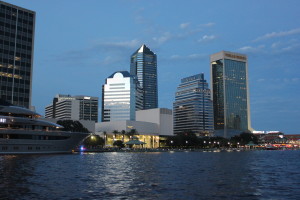It’s official: Metro Orlando will run out of water sometime in the next 20 years, and will need to take water from surrounding regions, says the state agency in charge of Florida’s water.
To meet Orlando’s 50% projected growth rate, the agencies identified 150 alternate sources of water in a one-thousand page study approved November 17.
The plan has gotten high praise from Central Florida businesses, utilities, and farmers, who now can expand and raise crops without worrying about their wells running dry. But it’s been soundly criticized by surrounding cities who object to having to help pay for growth they won’t see a nickel from. And environmentalists question the rationale of allowing Orlando to outgrow its water limits.
“We are on a path for disaster, just like California,” said Lisa Rinaman, head of environmental advocacy group, The St. Johns Riverkeeper.
Surrounded by Water; Not a Drop to Spare

Florida might seem like the last place that should have a water problem. It’s surrounded on three sides by ocean; there are thousands of lakes and rivers; and it gets 50 to 60 inches of rain per year, including regular deluges from hurricanes.
“We get plenty of water,” said Dr. Ann Shortelle, executive director of the St. Johns River Water Management District, one of the main authors of the new plan. “It just comes at inopportune times.”
In recent years, Florida has seen long droughts, followed by periods of intense rainfall. Shortelle said the land is unable to absorb the huge volume of rain quickly, so it runs off into the ocean, rather than seeping into underground caverns to recharge what’s pumped out for human consumption.
Rampant development over top of recharge areas contributes to runoff.
Florida’s drinking water comes from an underground rocky base that has caverns full of water. The caverns near the surface hold fresh water replenished by rain and caverns at lower depths hold saltwater. How the water flows underground from one part to the other wasn’t well understood until the last decade, said Shortelle, which is when officials realized some heavily populated areas will reach the limit of what they can pump.
That’s when a massive, statewide effort began to come up with a list of alternative sources of water. The plan includes better storm and wastewater reuse. It includes some conservation measures, although critics say not nearly enough. But what has been controversial are the plans for desalinization plants and river water withdrawals, both of which are expensive and have negative environmental impacts.
What the plan does not do, that has critics most upset, is question Orlando’s projected growth of 50%.
Tug-of War Begins
“Orlando doesn’t need more development,” North Florida resident Jim Tatum told the water management district board members during the public comment session prior to the vote.

“Our springs and rivers are dying on your watch,” he said, referring to reduced water levels in Central Florida lakes, rivers and springs that some say is caused by over-pumping.
Others are concerned about the water management districts continuing to issue large water withdrawal permits (called Consumptive Use Permits, or “CUPS” for short) while at the same time warning of water shortages.
“I get so tired of hearing we need to build all this expensive infrastructure to reuse water better,” said Steve Jenkins, a Jacksonville Waterways Commission member. “We aren’t the ones pumping it all out of the ground.”
Jenkins was referring to the fact that per capita use in Central Florida is higher than in his region, which was acknowledged by Shortelle during a public meeting on the plan. Metro Orlando’s numbers are higher, she said, in part because of tourism.
There were 55 million tourists in 2012 to the Orlando area, which has a permanent population of just over 2 million. In 2009, Forbes Magazine said it was the most visited city in the country. Florida’s Gov. Rick Scott has set goals to increase the number of tourists, which an Audubon group says will bring another 5 million visitors to the area. State Agricultural Commission chair Adam Putnam said the plan is important so tourism companies can feel confident “investing billions” in infrastructure over the coming decades knowing the state will provide access to water.
In addition, the biggest subdivision in the state is being built south of Orlando. With a projected 133,000 homes for 500,000 people, the controversial Deseret Ranch is in the process of getting its water permits. Environmental group 1000 Friends of Florida says it’s “the largest single development proposal in Florida’s history.”
“We have a problem of conflicting needs now – from golf courses to recreation to subdivisions to agriculture,” said environmental chemist Lisa Saupp, director of water-testing laboratory, Aqua Pure Water & Sewage Service, Inc. (not to be confused with the company of a similar name that sells filters) . “But we have to have clean drinking water.” Saupp and others say the state’s permitting process needs to be updated to reflect current water use.
“The Big Suck”
Saltwater intrusion. Sink holes. Dried up lakes.
That’s what opponents say will happen if Florida continues to suck more water out of its aquifer than it replenishes. As fresh water is depleted from the upper caverns, saltwater will, and already has in some places, intrude from below. In other cases, water depletion causes the surface to cave in, creating sink holes that have killed people and caused millions in property damage. Sink holes have occurred during droughts, which some say over-pumping will cause to increase. Springs, lakes and rivers that are fed from the aquifer are already lower in the Central Florida area, leaving docks dangling in the air.
Environmentalists and some scientists are concerned about over-pumping the aquifer, but they’re even more concerned in North Florida, where one of the region’s prime assets is on Orlando’s list: withdrawing water from the St. Johns River.
The river starts in Central Florida and flows north 310 miles, dumping into the Atlantic Ocean in Jacksonville. It’s a huge economic and recreational resource for North Florida, but because the area’s flat elevation causes it to flow slowly, it has trouble flushing out pollutants.
“All the bad stuff that happens in Central Florida ends up here,” said Riverkeeper’s Rinaman, referring to the build-up of pollutants in the water that often creates green algae “blooms” and fish kills in the northern end of the river.
The St. Johns Riverkeeper created a campaign called “The Big Suck” to raise awareness about how water withdrawals in one region can harm the river in another. Executive Director Jimmy Orth said the state’s plan is flawed because it focuses just on finding enough water for Central Florida and not enough on the effect of over-pumping on water quality.
“This is profoundly imprudent public policy,” wrote geologist Jim Gross, in an editorial in The Gainesville Sun in August referring to the state continually tapping ground water supplies.
High Praise from Central Florida
Not everyone was unhappy with the plan. Central Florida officials came out in great numbers to praise the plan and the process.
Orlando Mayor Buddy Dyer sent a representative to express his support for the plan that he said was needed to “responsibly” prepare for the future. A spokesperson for the Mayor of Groveland said the plan was necessary to avoid the water wars that occurred in the Tampa area in the ‘90s where “the only victor was the attorneys.”
A Seminole County Environmental Services spokesperson praised the “collaborative” nature of the process where the district spent years getting feedback from users. Brian Wheeler, executive director of a central Florida water authority, said in his 31 years of experience, “this was the most collaborative, open, transparent process” he had ever seen. “We had a seat at the table rather than being told after the fact.”
Farmers are happy with the plan; no agricultural group spoke against it. A spokesperson representing Central Florida agricultural producers said the industry has already adopted as much conservation efforts as they can afford, and are satisfied they’ll be able to meet their water needs in the future.
What Now?
Mary Ellen Winkler, attorney for the St. Johns River Water Management District, said within 18 months of the November vote, local governments will have to identify which of the 150 options they choose, and amend their formal city plans.
The district estimates cost for all 150 projects to be between $3.5 and $4.5 billion dollars. But cost won’t hit taxpayers and rate payers for several years, and so far there hasn’t been much feedback from citizens. But Audubon’s Chris Farrell said, “People should realize they can save hundreds in property taxes if they choose conservation over expensive infrastructure projects.”
For citizens who don’t want to see Central Florida outgrow its resources, Jacksonville University marine biologist Dr. Quinton White has some advice. He says citizens should contact their elected officials, even low-level officials, because feedback from the public gets communicated up and down the line.
“Tell them, ‘I’m watching how you vote,’” he said.


Leave a Reply